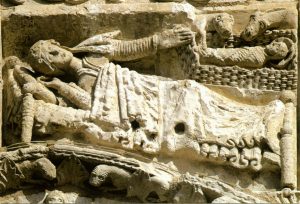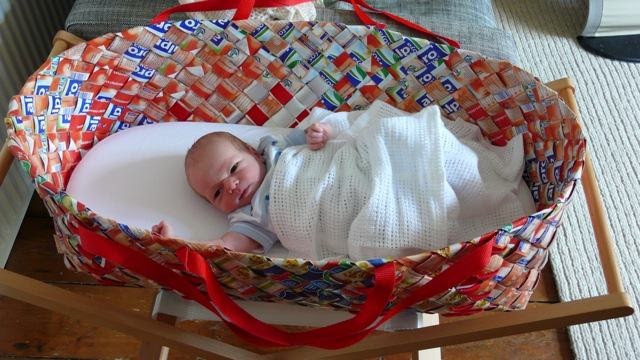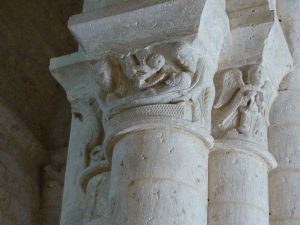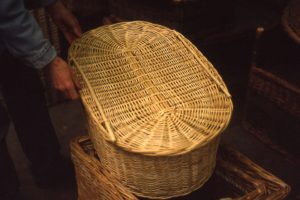Woven cradles to coffins
 Lois describes churches Poitou Charentes on pilgrim routes to Santiago de Compostela in Galicia.
Lois describes churches Poitou Charentes on pilgrim routes to Santiago de Compostela in Galicia.
At Notre Dame la Grande, in Poitiers, a carved stone facade that is is breathtaking for its detail. Just above the right hand doorway on the west facade is a 12th Century carving of a nativity scene (pictured above) with Mary showing the world her somewhat adult looking new born in his woven cradle overlooked by two animals which look, rather scarily, as though they might just eat him. The cradle is obviously wicker and given the ecology of the region would probably have been woven from hazel, chestnut or willow.
Woven cradles seem to have been neglected by basket makers in recent years yet I am certain there are many parents who would much rather have a cradle hand made from sustainable materials than a machine made pvc one. The hand made cradle used to be an object of desire that families treasured and handed on to the next generation. It would seem to be a tradition that is ripe for revival and what could be better than making one yourself?

photo:Jonathan Middup
I was delighted therefore to be sent this picture by Pip Hall (who, by a very strange coincidence, is a stone carver ) of a ‘moses’ basket made from tetra paks. Pip participates in workshops started by Monica Tweddell in Cumbria which she calls ‘crafty container’ workshops because, she tells me, they were inspired by my book of the same name. This beautiful basket was made by Elizabeth Dawson, a fellow participant, for her neices son William and is plaited out of approximately 44 soya milk cartons.
 Melle in Deux Sevres was considered such an important staging post on the pilgrim trail that three churches were built at about the same time each requiring a small army of masons and here high on a capitol in St. Pierre is a less detailed but nevertheless clear rendering of Jesus being laid in a woven coffin. (above)
Melle in Deux Sevres was considered such an important staging post on the pilgrim trail that three churches were built at about the same time each requiring a small army of masons and here high on a capitol in St. Pierre is a less detailed but nevertheless clear rendering of Jesus being laid in a woven coffin. (above)
The revival of the woven coffin in recent years has been, in my view, a basket making success story. Both the owner occupier versions and those crafted by professionals seem infinitely more humane than the gloss varnished exotic hardwood, or worse still, mdf and brass handled caskets that are not only environmentally dubious but have a grim formality about them that says nothing about the person inside.

The Somerset Willow Company has made a speciality of woven coffins and this one made for a child has a simplicity and beauty that seemed perfect to me when I saw it being made. Perhaps it is the similarity between the woven cradle and the woven coffin that suggests that a life has come full circle and the physical body is now returning from whence it came that makes it in some very small way, comforting.
Lois Walpole, Britain

PROFILE
Lois Walpole is of Anglo Scottish heritage and trained in Sculpture, Basket Making and Design.
She works full time as an artist/basket maker taking part in and curating national and international exhibitions, working to commission, designing for production, teaching and writing.
She divides her time between the Shetland Islands and the Charente, in south west France, where her studio is based.
Her blog gives the latest about her teaching and exhibitions and is where she talks about the baskets and basket related things that she finds interesting, inspiring, infuriating and intriguing…
Her self imposed rules are “no materials purchased and basket making techniques employed wherever possible”.
